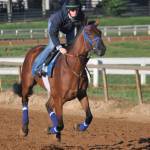Study Examines Sesamoid Bones in Horses

Horses have three sesamoid bones—two proximal and one distal, also known as the navicular bone—in each limb. These bones lie at the back of the fetlock where a number of tendons run over and between them. When the horse moves, the tendons are pulled against the sesamoid bones as the joint flexes.
Repeated excessive strain can cause fractures of the proximal sesamoid bone, often in the upper part of the medial (toward the center of the body) bone. This injury is fairly common in Thoroughbred and Standardbred horses in race training. Though two-year-old racehorses still have immature skeletons, the sesamoid bones have finished growing by this age.
Researchers from the University of Perugia in Italy looked at images of the proximal sesamoid bones in the forelegs of 27 Thoroughbreds as the horses began race training and again after a year of training. The initial scans showed variations in sesamoid size and shape between horses and also between the matched bones in the same horse.
In general, medial sesamoid bones were somewhat shorter and wider, while the lateral (away from the center of the body) bones tended to be taller and more narrow. Also, medial bones in right legs were usually wider than those in the left legs. No significant changes were noted in bone shape or size after a year of race training, though some horses had developed inflammation in and around the sesamoids.
The researchers suggested that conformation defects of the fetlock are responsible for asymmetrical loading as the horse moves, and this stress is more influential than sesamoid size or shape in producing inflammation.








